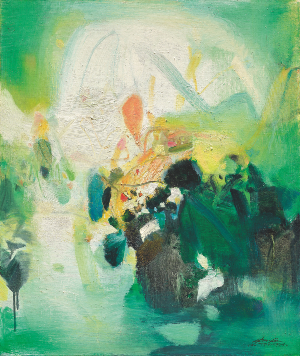EXHIBITED:
Albert Féraud &Chu Teh-Chun exhibition ,Gentilly Art center, Gentilly, November 9 - 24, 1985
This painting is to be sold with a certificate of authenticity issued by Chu The-chun studio.
Catalogue Note:
“The fusion of East and West is not just a process of putting things together; instead, it is a combination of ideas. I was educated in China, thus my oil painting integrates abstract painting with Chinese poetry. I prefer the artistic conception of the Tang and Song Dynasties.” - CHU Teh-chun
The uniqueness of Chu Teh-Chun's artistic ability hides within his mastery of landscapes and the poetry of the Tang and Song Dynasties. His modern abstract painting perfectly combines poetry, painting, and meaning, implementing the interpretation of “painting in poetry and poetry in painting” of the ancient Song Dynasty landscape painting. In the French art scene, he is hailed as the “Song Dynasty painter of the 20th century”. Born into a time of political turbulence, Chu Teh-Chun turned from the East to modern art in several decades after several transitions and cultural shifts. During this time, he stayed in Paris but was not fascinated by the popular painting school at the time. Instead he concentrated on creating a poetic landscape. He was invited by the Chinese University of Hong Kong to be a judge and visited China in 1983 once again. This time, he connected with the mountainous scenery of China and deepened the concept that has been implementing for many years in Western modern abstraction and Chinese landscapes. He created works based on Eastern atmospheres, which he blended with the characteristics of Western art.
LOOKING AT DISTANT SCENERY AS IF SEEING A FAIRY-TALE WORLD
The integration and compatibility of the Song Dynasty culture were expressed in poetry and painting. Chinese painting developed to a mature stage in the Northern Song Dynasty (960-1127). Landscape paintings of the Northern Song Dynasty utilize poetry to express space and lyrics. For example, in Linquan Gaozhi Ji, Guo Xi proposed that “poetry is an invisible painting, painting is a visible poem”; or a painter of the Northern Song Dynasty, Song Di, who specialized in painting “wintry, magnificent, elegant, and graceful” flat distance landscapes of misty water and trees. His Eight Views of Hsiao and Hsiang symbolizes the metaphorical cultural tradition of Hsiao Hsiang and contemplates on feelings arising from the inner lyrical tone. In the Song Dynasty, landscape for landscape painting was a way of thinking about culture, a construction of inner expressions or a way to symbolize environment. The prosperity of literature in the Song Dynasty was not only manifested in the literati's lyrical poetry as a means of chanting; painters lyricized landscape even more, and a landscape in the painting was no longer an objective image, rather, it subjectively reflected the feelings of the creator.
THE ATMOSPHERE OF THE RHYME LIKE NATURE ITSELF
Chu Teh-Chun's “landscape” originates from the scenery in his memory. In the paintings, he reinterprets the scenery he observes. The realistic scenery is ingeniously refined with the unique characteristics of the East and the West painting. He applies an abstract naturalistic approach by blending these unique cultural sources together to recreate the beauty of life. The light radiates out the vitality of life and evokes the charm of being detached from the object, or, “creating the emotion beyond the image,” as presented by the Tang Dynasty poet Tu Sikong in Twenty-Four Poems. Originally described as poetry’s artistic conception, the beauty of detachment is also a metaphor, which can also be applied describing to Chu Teh-Chun's paintings.
Chu Teh-Chun's abstract art evolved from the crimson tone of the 1960s and 1970s to the blue-green tone of the 1980s.“Jade Mountain” is painted in Chu’s favorite blue-green tone. Light, elegant, white, translucent, and radiant tones create the atmosphere of the painting. Which anticipating Chu’s later development of his distinctive style of “White lyricism”. Large brushstrokes painted in a smooth manner, like a brush bowing when moving up and down in Chinese calligraphy, like the rhyme and cadence of the music or dance and jumping interviewed together. Wu Guan-Zhong once said: “For Chu Teh-Chun's abstraction, objects in the foreground and background of a painting do not pose as constraints, but instead motivate the artist's pursuit of a deep spatiality that can coalesce with the concrete rhythms in his ink and brushwork. And this accounts for the ampleness of the depth and form in his work.”Inheriting composition and rhyme of the landscape painting of the Song Dynasty, Chu Teh-Chun paints snowy distant mountains covered in a floating haze, thus creating a penetrating space. Mist, Tree, Cloud, and Mountain depicts a distant but imposing, simple and elegant but filled with joy manner of expression, which allows the viewers to indulge in it, reflecting vivid feelings and displaying the forgotten cosmic atmosphere.“Jade Mountain” was part of the Albert FERAUD and CHU Teh-chun exhibition that took place between the 9th to the 24th of November 1985 at the Gentilly Art Center in France. It belonged to the collection of Mister Philippe N. the curator of this exhibition. The back of the painting is indeed dedicated
by Chu Teh-Chun to him “A Philippe bien amicalement” (To Philippe sincerely).
